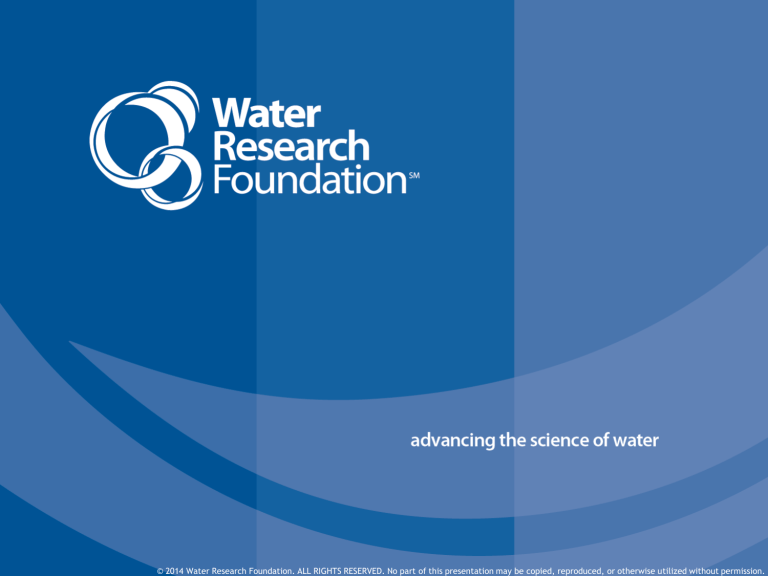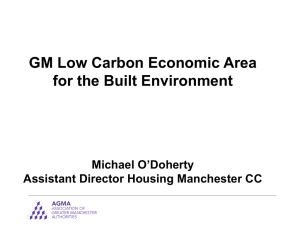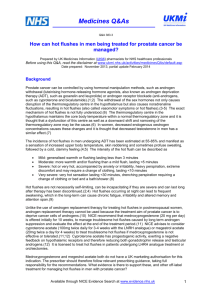
© 2014
Water Research
Foundation.
ALLwithout
RIGHTSpermission.
RESERVED.
© 2014 Water Research Foundation. ALL RIGHTS RESERVED. No part of this presentation may be copied,
reproduced,
or otherwise
utilized
Sustainable Water
Management Conference
Denver, Colorado
March 31, 2014
Presentation by William DeOreo, P.E.
© 2014 Water Research Foundation. ALL RIGHTS RESERVED.
Some Key Findings of the 2014
REUWS Update Study
WRF Project #4309
William DeOreo, P.E.
© 2014 Water Research Foundation. ALL RIGHTS RESERVED.
Project Advisory Committee
• Mr. David Bracciano, Demand Management Coordinator,
Tampa Bay Water
• Mr. Doug Bennett, Water Conservation Manager
Southern Nevada Water Authority
• Mr. Robert Day, Director of Customer Service, San Jose
Water Company
• Ms. Mary Ann Dickenson, Executive Director, Alliance for
Water Efficiency
• Mr. Warren Liebold, Director of Conservation, New York
City, and
• Ms. Maureen Hodgins, Water Research Foundation
Research Manager
© 2014 Water Research Foundation. ALL RIGHTS RESERVED.
Participating Level 1 Water
Agencies
• The Denver, Colorado Water Department
• The City of Fort Collins, Colorado, Water
Department
• The City of Scottsdale, Arizona Water Department
• The San Antonio, Texas, Water System
• The Clayton County, Georgia, Water Authority
• The Toho, Florida Water Authority
• The Region of Peel, Ontario, Canada
• The Region of Waterloo, Ontario, Canada
• The City of Tacoma, Washington, Water Department
© 2014 Water Research Foundation. ALL RIGHTS RESERVED.
Participating Level 2 Agencies
•
•
•
•
•
•
•
•
•
•
•
•
•
•
•
•
•
City of Aurora Colorado Water, Department
City of Austin, Texas
City of Chicago, Illinois
City of Henderson, Nevada
City of Mountain View, California
City of San Diego, California
City of Santa Barbara, California
City of Santa Fe, New Mexico
Cobb County Water System, Georgia
Colorado Springs Utilities, Colorado
Town of Cary, N.C.
EPCOR, Edmonton, Alberta, Canada
Miami-Dade Water & Sewer, Florida
Otay Water District, California
Philadelphia, Pennsylvania Water Department
Portland Water Bureau, Oregon
Regional Water Authority, Connecticut
© 2014 Water Research Foundation. ALL RIGHTS RESERVED.
Our Research Partners
• National Research Center
— Dr. Thomas Miller, President
— Erin Caldwell
• Hazen and Sawyer
— Dr. Jack Kiefer
• Mr. William Gauley, P.E. President Gauley
Associates
• Dr. Benedykt Dziegielewski, University of
Southern Illinois
• Peter Mayer, P.E., Principal, Water Demand
Management
© 2014 Water Research Foundation. ALL RIGHTS RESERVED.
Objectives of Study
• Obtain new flow trace data on a national
sample of single family homes
• Disaggregate flow trace data into end uses
of water
• Compile water use data into a database
• Link water use to survey data
• Prepare statistical analyses and models
• Compare results to previous studies
• Explore conservation potential and
benchmarks
© 2014 Water Research Foundation. ALL RIGHTS RESERVED.
Some Key Findings
• Reduction in Domestic Use has occurred
• Big improvements in toilets and clothes washers
— Only categories which show statistically
significant reductions.
• Skewed Uses need special attention
— Leakage (still number 5 category, just below CW)
— Irrigation (small number of big users raise the
mean)
• At least 20% potential for indoor conservation
remains.
• Landscape use is quite varied, but follows similar
patterns among groups.
© 2014 Water Research Foundation. ALL RIGHTS RESERVED.
Drop in Domestic Use Box Plot of Indoor GPD
• Median Use levels have
dropped from 160 gpd in
REUWS1 to 125 gpd in
REUWS2
• That is a 21% reduction
in indoor use
• The number of persons
per home has not
changed significantly
• These reductions are
due mainly to use of
better efficiency toilets
and clothes washers
© 2014 Water Research Foundation. ALL RIGHTS RESERVED.
Significant Changes in Toilets and Clothes
Washer use
© 2014 Water Research Foundation. ALL RIGHTS RESERVED.
Shift in flush volumes
•
•
•
•
Toilet flush distributions
This graph shows
distributions of individual
toilet flushes logged during
REUWS1 and REUWS2
1999 Data are in dark blue;
show bulk of flush volumes
around 4.5 gallon, with a
second peak at 1.75 gallon.
2013 Data are in light blue,
show major peak at 1.75
gallon and greatly
diminished percentages at
the 4 gallon level.
In 10 years the flushes will
probably be normally
distributed around the 1.75
gallon bin.
© 2014 Water Research Foundation. ALL RIGHTS RESERVED.
Fewer Homes with
mixtures of toilets
30%
100%
90%
25%
70%
20%
60%
15%
10%
50%
These 33% of homes
have almost ALL low
volume toilet flushes
40%
30%
Cumulative Frequency
80%
These 27% of homes
have almost no low
volume toilet flushes,
Relative Frequency
• More homes are showing
higher percentages of
low volume flushes
• ~30% of homes have
over 90% of flushes < 2.2
gal
• ~ 30% have less than
10% flushes < 2.2 gal
• ~40% have mixtures
• So, up to 70% of homes
are still candidates for
toilet retrofits.
Toilet Heterogeneity
20%
5%
10%
0%
5% 10% 15% 20% 25% 30% 35% 40% 45% 50% 55% 60% 65% 70% 75% 80% 85% 90% 95%
100
%
0%
% of
19% 7% 5% 3% 3% 3% 2% 2% 3% 3% 3% 4% 2% 2% 2% 2% 1% 3% 3% 27%
Homes
Cum % 19% 27% 31% 34% 37% 40% 43% 45% 48% 51% 53% 57% 60% 61% 63% 65% 67% 70% 73% 100%
Percent of Homes with Toilet Flushes < 2.2 gal
© 2014 Water Research Foundation. ALL RIGHTS RESERVED.
Skewed Nature of
Leakage
•
•
•
•
•
Leakage is highly skewed
by a few homes.
Average leakage rate was
17 gpd, but median was
4 gpd.
Top 21 homes, 3%,
accounted for 30% of
total leakage in group of
762
10% of the homes were
leaking at ~105 gpd; 90%
were leaking at 8 gpd.
Keeping leakage at the
median (~5 gpd) would
save 12 gpd on average,
or 4 kgal per year.
© 2014 Water Research Foundation. ALL RIGHTS RESERVED.
Hot Water Use
Hot Water by end use
•
•
•
•
•
•
•
Average homes used ~42
gpd of hot water
This was ~30% of total use
On average the homes use
753,000 BTU/Mo for
heating water
Maximum was 1.06 MBTU in
Tacoma
Minimum was 321,000 BTU
in Scottsdale
Showers are the #1 hot
water user, followed by
faucet use.
Clothes washing is a
relatively small hot water
user.
© 2014 Water Research Foundation. ALL RIGHTS RESERVED.
Application ratios are
biased by high users
• Most homeowners are
UNDER irrigating.
• Nearly 80% of homes in
the study were applying
less than the theoretical
irrigation requirement.
• Irrigation is a lot like
leakage in that a few
large users are accounting
for the bulk of the excess
irrigation.
• Analysis is based on aerial
photos using a consistent
set of procedures for
estimating irrigated areas
and plant types plus Local
Net ET with allowanced
for irrigation system
efficiencies.
Skewed Irrigation
Applications
© 2014 Water Research Foundation. ALL RIGHTS RESERVED.
Order of Peaking:
Diurnal Patterns
Morning Peaks
Toilets
Showers
Faucets
Clothes Washers
Evening Peaks
Faucets
Toilets
Showers
Bath tubs
Clothes washers
Dish washers
Continuous
Leaks
Humidifiers
© 2014 Water Research Foundation. ALL RIGHTS RESERVED.
Current Use vs
Benchmarks
•
•
•
•
•
•
Savings Potential
Average Savings Potential =
31 gphd from switching to
Water Sense devices
Equates to 11 kgal per year
indoor
This is approximately 20%
of current indoor use
Does not include savings
from leakage control.
Leakage control would add
another 4 kgal per year.
Total savings are estimated
at 15 kgal per year for
indoor + leakage, or ~25%
of current use.
© 2014 Water Research Foundation. ALL RIGHTS RESERVED.
Benchmarks
By Extracting from
Historical Database:
Per Capita Benchmarks
70.0
60.0
50.0
Indoor Use (GPCD)
• Class 1 homes: meet
WaterSense standards.
Current best available
efficiency with off-theshelf equipment
• Class 2 homes:
Intermediate efficiency
based on most homes
meeting NEPA standards.
• Class 3 homes: older
homes, pre-NEPA
40.0
30.0
20.0
10.0
0.0
Indoor Use
Cl_1
Cl_2
Cl_3
42.7
50.1
59.9
© 2014 Water Research Foundation. ALL RIGHTS RESERVED.
Non-linear Relationship
Household use v
residents
300
y = 50x0.77
250
Household Use (gpd)
• Not correct to scale up
per-capita use on a
linear basis
• Household use
relationship follows a
power curve
• Exponent is normally
less than one
• Curve shown is for high
efficiency homes (Class
1)
• Class 2 and 3 homes
would have a different
curve, but similar form.
200
150
100
50
0
0
2
4
6
8
10
Number of Residents
© 2014 Water Research Foundation. ALL RIGHTS RESERVED.
Conclusions
• Keep up with the high efficiency toilets and clothes washers
• Consider things like upgrade-on-sale ordinances to
accelerate adoption
• Focus on high users for conservation
• Consider water budgets to put a premium price on high
consumption
• Attach a capital value to the water over and above the cost
of service
• Deal with leakage in the 10%’ers: either install sensors, or
use AMR to send alerts
• Use the high efficiency benchmark values for planning
purposes, not the historical values, which are obsolete.
© 2014 Water Research Foundation. ALL RIGHTS RESERVED.
Thank you
• Contact:
William DeOreo, P.E.
Aquacraft, Inc.
2709 Pine Street, Boulder CO, 80302
303-786-9691
bill@aquacraft.com
www.aquacraft.com
© 2014 Water Research Foundation. ALL RIGHTS RESERVED.










